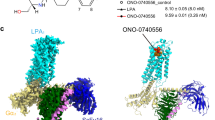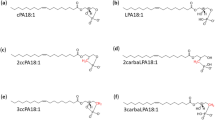Abstract
Autotaxin (ATX, also known as Enpp2) is a secreted lysophospholipase D that hydrolyzes lysophosphatidylcholine to generate lysophosphatidic acid (LPA), a lipid mediator that activates G protein–coupled receptors to evoke various cellular responses. Here, we report the crystal structures of mouse ATX alone and in complex with LPAs with different acyl-chain lengths and saturations. These structures reveal that the multidomain architecture helps to maintain the structural rigidity of the lipid-binding pocket, which accommodates the respective LPA molecules in distinct conformations. They indicate that a loop region in the catalytic domain is a major determinant for the substrate specificity of the Enpp family enzymes. Furthermore, along with biochemical and biological data, these structures suggest that the produced LPAs are delivered from the active site to cognate G protein–coupled receptors through a hydrophobic channel.
This is a preview of subscription content, access via your institution
Access options
Subscribe to this journal
Receive 12 print issues and online access
$189.00 per year
only $15.75 per issue
Buy this article
- Purchase on Springer Link
- Instant access to full article PDF
Prices may be subject to local taxes which are calculated during checkout






Similar content being viewed by others
References
Stracke, M.L. et al. Identification, purification, and partial sequence analysis of autotaxin, a novel motility-stimulating protein. J. Biol. Chem. 267, 2524–2529 (1992).
Umezu-Goto, M. et al. Autotaxin has lysophospholipase D activity leading to tumor cell growth and motility by lysophosphatidic acid production. J. Cell Biol. 158, 227–233 (2002).
Tokumura, A. et al. Identification of human plasma lysophospholipase D, a lysophosphatidic acid-producing enzyme, as autotaxin, a multifunctional phosphodiesterase. J. Biol. Chem. 277, 39436–39442 (2002).
Noguchi, K., Herr, D., Mutoh, T. & Chun, J. Lysophosphatidic acid (LPA) and its receptors. Curr. Opin. Pharmacol. 9, 15–23 (2009).
Moolenaar, W.H., van Meeteren, L.A. & Giepmans, B.N. The ins and outs of lysophosphatidic acid signaling. Bioessays 26, 870–881 (2004).
Contos, J.J., Fukushima, N., Weiner, J.A., Kaushal, D. & Chun, J. Requirement for the lpA1 lysophosphatidic acid receptor gene in normal suckling behavior. Proc. Natl. Acad. Sci. USA 97, 13384–13389 (2000).
Tanaka, M. et al. Autotaxin stabilizes blood vessels and is required for embryonic vasculature by producing lysophosphatidic acid. J. Biol. Chem. 281, 25822–25830 (2006).
van Meeteren, L.A. et al. Autotaxin, a secreted lysophospholipase D, is essential for blood vessel formation during development. Mol. Cell. Biol. 26, 5015–5022 (2006).
Kanda, H. et al. Autotaxin, an ectoenzyme that produces lysophosphatidic acid, promotes the entry of lymphocytes into secondary lymphoid organs. Nat. Immunol. 9, 415–423 (2008).
Inoue, M. et al. Initiation of neuropathic pain requires lysophosphatidic acid receptor signaling. Nat. Med. 10, 712–718 (2004).
Liu, S. et al. Expression of autotaxin and lysophosphatidic acid receptors increases mammary tumorigenesis, invasion, and metastases. Cancer Cell 15, 539–550 (2009).
Yang, S.Y. et al. Expression of autotaxin (NPP-2) is closely linked to invasiveness of breast cancer cells. Clin. Exp. Metastasis 19, 603–608 (2002).
Stassar, M.J. et al. Identification of human renal cell carcinoma associated genes by suppression subtractive hybridization. Br. J. Cancer 85, 1372–1382 (2001).
Baumforth, K.R. et al. Induction of autotaxin by the Epstein-Barr virus promotes the growth and survival of Hodgkin lymphoma cells. Blood 106, 2138–2146 (2005).
Zhang, G., Zhao, Z., Xu, S., Ni, L. & Wang, X. Expression of autotaxin mRNA in human hepatocellular carcinoma. Chin. Med. J. 112, 330–332 (1999).
Masuda, A. et al. Serum autotaxin measurement in haematological malignancies: a promising marker for follicular lymphoma. Br. J. Haematol. 143, 60–70 (2008).
Kishi, Y. et al. Autotaxin is overexpressed in glioblastoma multiforme and contributes to cell motility of glioblastoma by converting lysophosphatidylcholine to lysophosphatidic acid. J. Biol. Chem. 281, 17492–17500 (2006).
Hama, K. et al. Lysophosphatidic acid and autotaxin stimulate cell motility of neoplastic and non-neoplastic cells through LPA1 . J. Biol. Chem. 279, 17634–17639 (2004).
Parrill, A.L. & Baker, D.L. Autotaxin inhibition: challenges and progress toward novel anti-cancer agents. Anticancer Agents Med. Chem. 8, 917–923 (2008).
Stefan, C., Jansen, S. & Bollen, M. NPP-type ectophosphodiesterases: unity in diversity. Trends Biochem. Sci. 30, 542–550 (2005).
Cimpean, A., Stefan, C., Gijsbers, R., Stalmans, W. & Bollen, M. Substrate-specifying determinants of the nucleotide pyrophosphatases/phosphodiesterases NPP1 and NPP2. Biochem. J. 381, 71–77 (2004).
Tabata, S. et al. A rapid screening method for cell lines producing singly tagged recombinant proteins using the 'TARGET tag' system. J. Proteomics 73, 1777–1785 (2010).
Jansen, S. et al. Proteolytic maturation and activation of autotaxin (NPP2), a secreted metastasis-enhancing lysophospholipase D. J. Cell Sci. 118, 3081–3089 (2005).
Zhou, A., Huntington, J.A., Pannu, N.S., Carrell, R.W. & Read, R.J. How vitronectin binds PAI-1 to modulate fibrinolysis and cell migration. Nat. Struct. Biol. 10, 541–544 (2003).
Deng, G., Royle, G., Wang, S., Crain, K. & Loskutoff, D.J. Structural and functional analysis of the plasminogen activator inhibitor-1 binding motif in the somatomedin B domain of vitronectin. J. Biol. Chem. 271, 12716–12723 (1996).
van Meeteren, L.A. & Moolenaar, W.H. Regulation and biological activities of the autotaxin–LPA axis. Prog. Lipid Res. 46, 145–160 (2007).
Lee, H.Y. et al. Stimulation of tumor cell motility linked to phosphodiesterase catalytic site of autotaxin. J. Biol. Chem. 271, 24408–24412 (1996).
Clair, T. et al. Autotaxin hydrolyzes sphingosylphosphorylcholine to produce the regulator of migration, sphingosine-1-phosphate. Cancer Res. 63, 5446–5453 (2003).
Gijsbers, R., Aoki, J., Arai, H. & Bollen, M. The hydrolysis of lysophospholipids and nucleotides by autotaxin (NPP2) involves a single catalytic site. FEBS Lett. 538, 60–64 (2003).
Gijsbers, R., Ceulemans, H., Stalmans, W. & Bollen, M. Structural and catalytic similarities between nucleotide pyrophosphatases/phosphodiesterases and alkaline phosphatases. J. Biol. Chem. 276, 1361–1368 (2001).
Zalatan, J.G., Fenn, T.D., Brunger, A.T. & Herschlag, D. Structural and functional comparisons of nucleotide pyrophosphatase/phosphodiesterase and alkaline phosphatase: implications for mechanism and evolution. Biochemistry 45, 9788–9803 (2006).
Dennis, J. et al. Phosphodiesterase-Iα/autotaxin's MORFO domain regulates oligodendroglial process network formation and focal adhesion organization. Mol. Cell. Neurosci. 37, 412–424 (2008).
Ghosh, M., Meiss, G., Pingoud, A., London, R.E. & Pedersen, L.C. Structural insights into the mechanism of nuclease A, a ββα metal nuclease from Anabaena. J. Biol. Chem. 280, 27990–27997 (2005).
Jansen, S. et al. An essential oligomannosidic glycan chain in the catalytic domain of autotaxin, a secreted lysophospholipase-D. J. Biol. Chem. 282, 11084–11091 (2007).
Jansen, S., Andries, M., Derua, R., Waelkens, E. & Bollen, M. Domain interplay mediated by an essential disulfide linkage is critical for the activity and secretion of the metastasis-promoting enzyme autotaxin. J. Biol. Chem. 284, 14296–14302 (2009).
Sakagami, H. et al. Biochemical and molecular characterization of a novel choline-specific glycerophosphodiester phosphodiesterase belonging to the nucleotide pyrophosphatase/phosphodiesterase family. J. Biol. Chem. 280, 23084–23093 (2005).
van Meeteren, L.A. et al. Inhibition of autotaxin by lysophosphatidic acid and sphingosine 1-phosphate. J. Biol. Chem. 280, 21155–21161 (2005).
Winkler, F.K., D'Arcy, A. & Hunziker, W. Structure of human pancreatic lipase. Nature 343, 771–774 (1990).
Sheldrick, G.M. A short history of SHELX. Acta Crystallogr. A 64, 112–122 (2008).
The CCP4 suite: programs for protein crystallography. Acta Crystallogr. D Biol. Crystallogr. 50, 760–763 (1994).
Terwilliger, T.C. & Berendzen, J. Automated MAD and MIR structure solution. Acta Crystallogr. D Biol. Crystallogr. 55, 849–861 (1999).
Emsley, P. & Cowtan, K. Coot: model-building tools for molecular graphics. Acta Crystallogr. D Biol. Crystallogr. 60, 2126–2132 (2004).
Adams, P.D. et al. PHENIX: building new software for automated crystallographic structure determination. Acta Crystallogr. D Biol. Crystallogr. 58, 1948–1954 (2002).
Vagin, A. & Teplyakov, A. Molecular replacement with MOLREP. Acta Crystallogr. D Biol. Crystallogr. 66, 22–25 (2010).
Holm, L., Kaariainen, S., Rosenstrom, P. & Schenkel, A. Searching protein structure databases with DaliLite v.3. Bioinformatics 24, 2780–2781 (2008).
Tsuda, S. et al. Cyclic phosphatidic acid is produced by autotaxin in blood. J. Biol. Chem. 281, 26081–26088 (2006).
Acknowledgements
We are grateful to the beam-line staffs at NW12A and NE3A of KEK PF-AR and BL41XU of SPring-8 for assistance in data collection. We thank L. Bonnefond (University of Tokyo, Japan) for critical reading of the manuscript. This work was supported by a grant for the National Project on Protein Structural and Functional Analyses from the Ministry of Education, Culture, Sports, Science and Technology (MEXT) to O.N. and J.A., by a National Institute of Biomedical Innovation (Japan) grant to J.A. and by MEXT grants to R.I. and O.N.
Author information
Authors and Affiliations
Contributions
H.N. crystallized and determined the structure of ATX and wrote the paper; S.O., K.H. and A.I. conducted biochemical and cell biological analyses of the wild-type and mutant ATXs; E.M. and J.T. prepared the recombinant ATX proteins; A.I., N.D. and J.A. did the mass spectrometry analysis of endogenous LPA; R.I. assisted with the structural determination; and O.N. designed the work and also assisted with the structure determination. All authors discussed the results and commented on the manuscript; O.N., J.A. and J.T. supervised the work.
Corresponding authors
Ethics declarations
Competing interests
The authors declare no competing financial interests.
Supplementary information
Supplementary Text and Figures
Supplementary Figures 1–8, Supplementary Table 1 and Supplementary Discussion (PDF 4596 kb)
Rights and permissions
About this article
Cite this article
Nishimasu, H., Okudaira, S., Hama, K. et al. Crystal structure of autotaxin and insight into GPCR activation by lipid mediators. Nat Struct Mol Biol 18, 205–212 (2011). https://doi.org/10.1038/nsmb.1998
Received:
Accepted:
Published:
Issue Date:
DOI: https://doi.org/10.1038/nsmb.1998
This article is cited by
-
2-Carba-lysophosphatidic acid is a novel β-lysophosphatidic acid analogue with high potential for lysophosphatidic acid receptor activation and autotaxin inhibition
Scientific Reports (2021)
-
Zinc deficiency causes delayed ATP clearance and adenosine generation in rats and cell culture models
Communications Biology (2018)
-
Crystal structure and substrate binding mode of ectonucleotide phosphodiesterase/pyrophosphatase-3 (NPP3)
Scientific Reports (2018)
-
Structural insights into ligand recognition by the lysophosphatidic acid receptor LPA6
Nature (2017)
-
Steroid binding to Autotaxin links bile salts and lysophosphatidic acid signalling
Nature Communications (2016)



